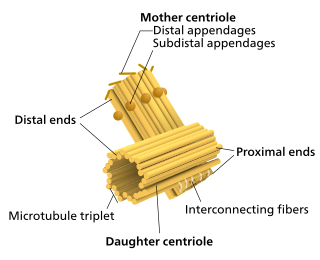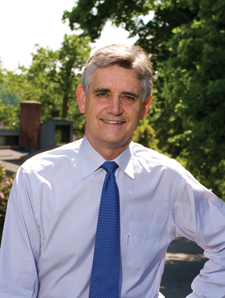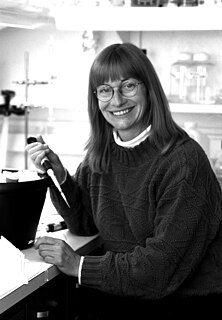
Prions are misfolded proteins with the ability to transmit their misfolded shape onto normal variants of the same protein. They characterize several fatal and transmissible neurodegenerative diseases in humans and many other animals. It is not known what causes the normal protein to misfold, but the abnormal three-dimensional structure is suspected of conferring infectious properties, collapsing nearby protein molecules into the same shape. The word prion derives from "proteinaceous infectious particle". The hypothesized role of a protein as an infectious agent stands in contrast to all other known infectious agents such as viroids, viruses, bacteria, fungi, and parasites, all of which contain nucleic acids.

Yeasts are eukaryotic, single-celled microorganisms classified as members of the fungus kingdom. The first yeast originated hundreds of millions of years ago, and at least 1,500 species are currently recognized. They are estimated to constitute 1% of all described fungal species.

Susan Lee Lindquist, ForMemRS was an American professor of biology at MIT specializing in molecular biology, particularly the protein folding problem within a family of molecules known as heat-shock proteins, and prions. Lindquist was a member and former director of the Whitehead Institute and was awarded the National Medal of Science in 2010.

Stanley Benjamin Prusiner is an American neurologist and biochemist. He is the director of the Institute for Neurodegenerative Diseases at University of California, San Francisco (UCSF). Prusiner discovered prions, a class of infectious self-reproducing pathogens primarily or solely composed of protein. He received the Albert Lasker Award for Basic Medical Research in 1994 and the Nobel Prize in Physiology or Medicine in 1997 for prion research developed by him and his team of experts beginning in the early 1970s.

Saccharomyces cerevisiae is a species of yeast. The species has been instrumental in winemaking, baking, and brewing since ancient times. It is believed to have been originally isolated from the skin of grapes. It is one of the most intensively studied eukaryotic model organisms in molecular and cell biology, much like Escherichia coli as the model bacterium. It is the microorganism behind the most common type of fermentation. S. cerevisiae cells are round to ovoid, 5–10 μm in diameter. It reproduces by budding.

Yeast artificial chromosomes (YACs) are genetically engineered chromosomes derived from the DNA of the yeast, Saccharomyces cerevisiae, which is then ligated into a bacterial plasmid. By inserting large fragments of DNA, from 100–1000 kb, the inserted sequences can be cloned and physically mapped using a process called chromosome walking. This is the process that was initially used for the Human Genome Project, however due to stability issues, YACs were abandoned for the use of Bacterial artificial chromosomes (BAC). Beginning with the initial research of the Rankin et al., Strul et al., and Hsaio et al., the inherently fragile chromosome was stabilized by discovering the necessary autonomously replicating sequence (ARS); a refined YAC utilizing this data was described in 1983 by Murray et al.

Structural inheritance or cortical inheritance is the transmission of an epigenetic trait in a living organism by a self-perpetuating spatial structures. This is in contrast to the transmission of digital information such as is found in DNA sequences, which accounts for the vast majority of known genetic variation.
Sup35p is the Saccharomyces cerevisiae eukaryotic translation release factor. More specifically, it is the yeast eukaryotic release factor 3 (eRF3), which forms the translation termination complex with eRF1. This complex recognizes and catalyzes the release of the nascent polypeptide chain when the ribosome encounters a stop codon. While eRF1 recognizes stop codons, eRF3 facilitates the release of the polypeptide chain through GTP hydrolysis.

A fungal prion is a prion that infects fungal hosts. Fungal prions are naturally occurring proteins that can switch between multiple, structurally distinct conformations, at least one of which is self-propagating and transmissible to other prions. This transmission of protein state represents an epigenetic phenomenon where information is encoded in the protein structure itself, instead of in nucleic acids. Several prion-forming proteins have been identified in fungi, primarily in the yeast Saccharomyces cerevisiae. These fungal prions are generally considered benign, and in some cases even confer a selectable advantage to the organism.
Anti-Saccharomyces cerevisiae antibodies (ASCAs) are antibodies against antigens presented by the cell wall of the yeast Saccharomyces cerevisiae. These antibodies are directed against oligomannose sequences α-1,3 Man n. ASCAs and perinuclear antineutrophil cytoplasmic antibodies (pANCAs) are the two most useful and often discriminating biomarkers for colitis. ASCA tends to recognize Crohn's disease more frequently, whereas pANCA tend to recognize ulcerative colitis.
A killer yeast is a yeast, such as Saccharomyces cerevisiae, which is able to secrete one of a number of toxic proteins which are lethal to susceptible cells. These "killer toxins" are polypeptides that kill sensitive cells of the same or related species, often functioning by creating pores in target cell membranes. These yeast cells are immune to the toxic effects of the protein due to an intrinsic immunity. Killer yeast strains can be a problem in commercial processing because they can kill desirable strains. The killer yeast system was first described in 1963. Study of killer toxins helped to better understand the secretion pathway of yeast, which is similar to those of more complex eukaryotes. It also can be used in treatment of some diseases, mainly those caused by fungi.
Ure2, or Ure2p, is a yeast protein encoded by a gene known as URE2. The Ure2 protein can also form a yeast prion known as [URE3]. When Ura2p is expressed at high levels in yeast, it will readily convert from its native protein conformation into an aggregate known as an amyloid. [URE3], along with [PSI+], were both determined by Wickner (1994) to meet the genetic definition of a yeast prion.

Bruce William Stillman, AO, FAA, FRS is a biochemist and cancer researcher who has served as the Director of Cold Spring Harbor Laboratory (CSHL) since 1994 and President since 2003. He also served as the Director of its NCI-designated Cancer Center for 25 years from 1992 to 2016. During his leadership, CSHL has been ranked as the No. 1 institution in molecular biology and genetics research by Thomson Reuters. Stillman's research focuses on how chromosomes are duplicated in human cells and in yeast Saccharomyces cerevisiae; the mechanisms that ensure accurate inheritance of genetic material from one generation to the next; and how missteps in this process lead to cancer. For his accomplishments, Stillman has received numerous awards, including the Alfred P. Sloan, Jr. Prize in 2004 and the 2010 Louisa Gross Horwitz Prize, both of which he shared with Thomas J. Kelly of Memorial Sloan-Kettering Cancer Center, as well as the 2019 Canada Gairdner International Award for biomedical research, which he shared with John Diffley.

Jens Nielsen is the CEO of BioInnovation Institute, Copenhagen, Denmark and Professor of Systems Biology at Chalmers University of Technology, Gothenburg, Sweden. He is Adjunct Professor at the Technical University of Denmark. He is the most cited researcher in the field of metabolic engineering, and he is the founding president of the International Metabolic Engineering Society. Jens Nielsen is the founder of several biotech companies.
In molecular biology, the Ure2 internal ribosome entry site (IRES) is an RNA element present in the 5' UTR of the mRNA of Ure2. It allows 5' cap- and eIF4E-independent translation of an N-terminally truncated form of Ure2. This truncated form lacks the prion-forming domain. It is a 104 nucleotide region, smaller than most viral IRES elements, which forms a stem-loop structure. EIF2A represses this IRES resulting in an inhibition of translation of the N-terminally truncated Ure2.

Leona D. Samson is the Uncas and Helen Whitaker Professor and American Cancer Society Research Professor of Biological Engineering at the Massachusetts Institute of Technology, where she served as the Director of the Center for Environmental Health Sciences from 2001 to 2012. Before her professorship at MIT, she held a professorship at the Harvard School of Public Health. She is on the editorial board of the journal DNA Repair. Her research interests focus on "methods for measuring DNA repair capacity (DRC) in human cells", research the National Institute of Health recognized as pioneering in her field, for which the NIH granted her the National Institutes of Health Director's Pioneer Award.

Fred Sherman was an American scientist who pioneered the use of the budding yeast Saccharomyces cerevisiae as a model for studying the genetics, molecular biology, and biochemistry of eukaryotic cells. His research encompassed broad areas of yeast biology including gene expression, protein synthesis, messenger RNA processing, bioenergetics, and mechanisms of mutagenesis. He also contributed extensively to the genetics of the opportunistic pathogen Candida albicans.

Fred Marshall Winston is the John Emory Andrus Professor of Genetics in the Harvard Medical School Genetics Department, where he has been a member of the faculty since 1983. Research in his laboratory has focused on mechanisms of transcription and the regulation of chromatin structure in the budding yeast Saccharomyces cerevisiae and the fission yeast Schizosaccharomyces pombe. Dr. Winston served as the President of the Genetics Society of America in 2009 and has been elected to both the American Academy of Arts and Sciences (2009) and the National Academy of Sciences (2013).

Sue Hengren Wickner is an American biochemist and geneticist who is a distinguished investigator and the head of the DNA Molecular Biology section of the National Institutes of Health. Her laboratory is under the National Cancer Institute and is located in the Center for Cancer Research (NCI/CCR).

Joseph Heitman is an American physician-scientist focused on research in genetics, microbiology, and infectious diseases. He is the James B. Duke Professor and Chair of the Department of Molecular Genetics and Microbiology at Duke University School of Medicine.














